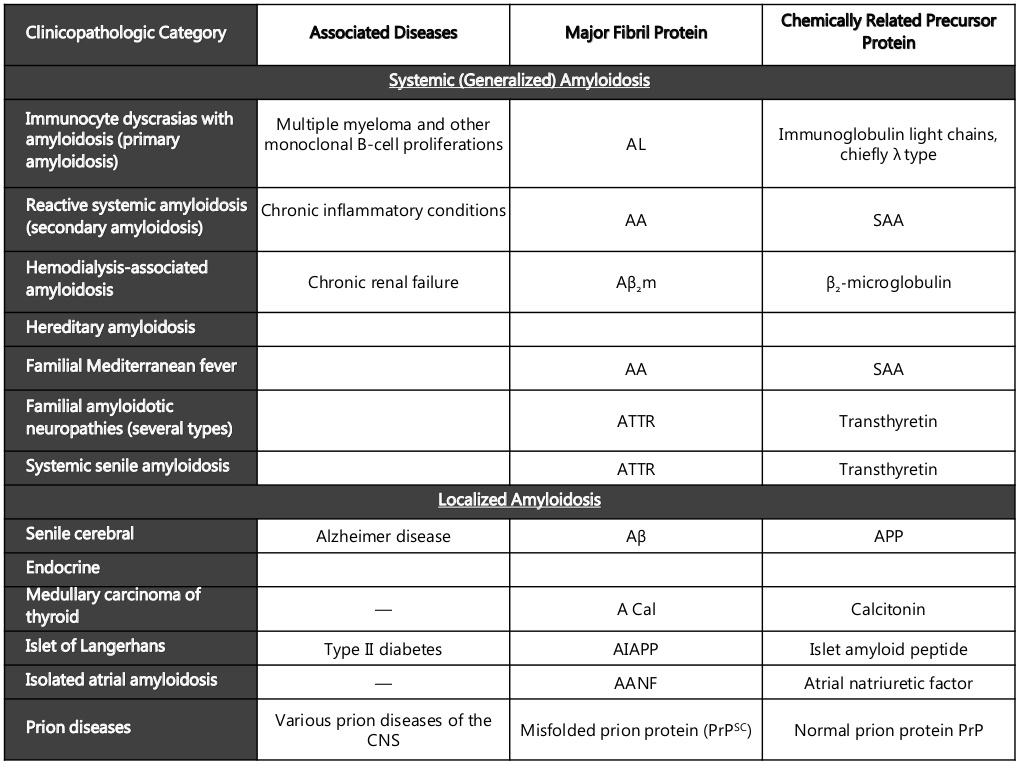Classification
Different proteins can be deposited as amyloid in various tissues
- deposition can be restricted to one specific site (such as pancreas, brain, larynx) (localized amyloidosis) or can be found throughout the body (systemic amyloidosis)
- are a many types of localized amyloidosis including cerebral endocrine, and cutaneous amyloidosis
- only the name amyloid is identical, but the localised types of amyloid mentioned above are completely different because of different precursor proteins
- only the name amyloid is identical, but the localised types of amyloid mentioned above are completely different because of different precursor proteins
- are a many types of localized amyloidosis including cerebral endocrine, and cutaneous amyloidosis
- five main types of systemic amyloidosis are:
- systemic forms of amyloid that should be distinguished from each other (four acquired and one hereditary) are AA, AL, Aß2M, and two ATTR types:
- acquired AA amyloidosis
- caused by chronic inflammation
- serum amyloid A protein (SAA), an acute phase reactant, is the precursor protein of this type
- proteinuria and loss of renal function are the most prominent clinical characteristics
- acquired AL amyloidosis
- caused by a plasma cell dyscrasia
- precursor protein of this type is a kappa or lambda immunoglobulin light chain
- clinical characteristics of this type are very diverse, such as cardiomyopathy, hepatomegaly, nephrotic syndrome, severe diarrhoea, carpal tunnel syndrome, and neuropathy (peripheral as well as autonomic neuropathy)
- acquired Aß2M amyloidosis
- caused by chronic dialysis because of complete renal failure
- precursor protein of this type is ß2-microglobulin because high serum levels are the result of the impossibility to excrete this protein
- clinical characteristics of this type are carpal tunnel syndrome and joint problems (shoulders, wrists, fingers, hips, vertebral column, etc.)
- caused by chronic dialysis because of complete renal failure
- acquired ATTR amyloidosis
- found at older age (especially older than 80 years)
- the normal wild type precursor protein transthyretin (TTR) is the characteristic protein
- clinically characterised by a slowly progressive cardiomyopathy
- hereditary ATTR amyloidosis
- caused by more than 80 autosomal dominant hereditary point mutations of the precursor protein transthyretin (TTR)
- clinical characteristics of this type are peripheral and autonomic neuropathy, but also cardiac, renal, and ocular involvement can be seen
- acquired AA amyloidosis
- systemic forms of amyloid that should be distinguished from each other (four acquired and one hereditary) are AA, AL, Aß2M, and two ATTR types:

Reference:
- Misumi Y, Ando Y.Classification of amyloidosis. Brain Nerve. 2014 Jul;66(7):731-7.
- Dey A. Classification of Amyloidosis.
Related pages
Create an account to add page annotations
Annotations allow you to add information to this page that would be handy to have on hand during a consultation. E.g. a website or number. This information will always show when you visit this page.